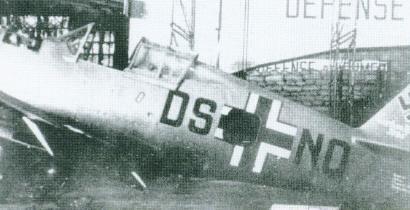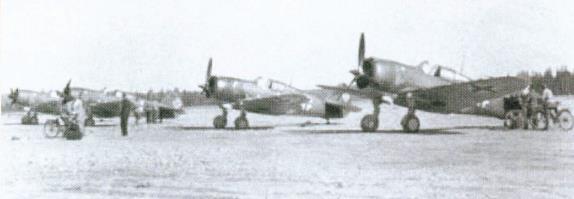| Type |
Single seat fighter |
| Engine |
1 Pratt & Whitney R-1830-17 Twin Wasp with 3-bladed constant speed propeller |
| Dimensions |
Length 8,69 m , height 2,57 m , span 11,38 m , wing area 21,92 m2 , airfoil: root: NACA 2215; tip: NACA 2209
|
| Weights |
Empty 2072 kg, loaded 2563 kg , max. take off weight 2726 kg |
| Performance |
Max.. speed 504 km/h , cruising speed 430 km/h , range 1006 km at 430 km/h,1380 km at 320 km/h, endurance , service ceiling 10000 m , climb 17 m/sec. |
| Armament |
Guns: 1 7.62 mm M1919 Browning machine gun , 1 12.70 mm M2 Browning machine gun
Bombs: some later fitted with a hardpoint under each wing that could carry a bomb of up to 45 kg or a light bomb rack for three 23 kg, five 9.1 kg or 14 kg bombs |
| German registration |
Unit |
History |
| KQ+KA |
|
|
| DS+NU |
Jagdfliegerschule 4, Fürth |
|
| DS+NQ |
Jagdfliegerschule 4, Fürth |
|
| 1 + 2 |
Erprobungsstelle Rechlin |
|
| 1 + 5 |
Erprobungsstelle Rechlin |
|
| 1 + 6 |
Erprobungsstelle Rechlin |
|
| 1 + 8 |
Erprobungsstelle Rechlin |
|
| 1 + 9 |
Erprobungsstelle Rechlin |
|
| 1 + 2 |
Erprobungsstelle Rechlin |
|
| KQ+ZA |
|
|
| KQ+ZB |
|
|
| RH+8 |
|
|
| G.+F. |
|
|
| GF+KE or GF+KF |
|
|
| German units using Hawk 75 |
| Erprobungsstelle Rechlin |
| III./JG 77 |
| Jagdfliegerschule 4 , Fürth |
| Type |
Werk.Nr |
Registration |
History |
|
24 |
NS+NQ |
JFS 4 |
|
|
RH+CD |
|
|
|
RH+CG |
|
|
|
RH+CH
|
|
|
|
RH+CL ? |
|
| A.4 |
|
RH+CM |
|
|
|
DS+NQ |
March.l943 I./JG104 Überf.Kdo Chef AW Le Bourget |
| A-4 |
|
DS+NU |
March 1943 JG104 JFS4 |
| A-4 |
50 or 34 |
KQ+ZA |
III/JG 27 |
| A-4 |
13821 |
KQ+ZB |
Erg. JGr Merseburg |
|
|
G + F |
|
|
|
GF+KE or GF+KF |
|
The Curtiss Model 75 was a private venture by the company, designed by former Northrop Aircraft Company engineer Don R. Berlin. The first prototype, constructed in 1934, featured all-metal construction with fabric-covered control surfaces, a Wright XR-1670-5 radial engine developing 900 hp (670 kW), and typical United States Army Air Corps (USAAC) armament of one 7.62 mm and one .12.7 mm machine gun firing through the propeller arc. Also typical of the time was the total absence of cockpit armor or self-sealing fuel tanks. The distinctive landing gear, which rotated 90° to fold the main wheels flat into the thin trailing portion of the wing, resting atop the lower ends of the maingear struts when retracted, was a Boeing-patented design for which Curtiss had to pay royalties.
The prototype first flew on 6 May 1935, reaching 452 km/h at 3,000 m during early test flights. On 27 May 1935, the prototype was flown to Wright Field, Ohio, to compete in the USAAC fly-off for a new single-seat fighter, but the contest was delayed because the Seversky entry crashed on its way there. Curtiss took advantage of the delay to replace the unreliable engine with a Wright XR-1820-39 Cyclone producing 950 hp (710 kW) and to rework the fuselage, adding the distinctive scalloped rear windows to improve visibility. The new prototype was designated Model 75B with the R-1670 version retroactively designated Model 75D. The fly-off finally took place in April 1936. Unfortunately, the new engine failed to deliver its rated power and the aircraft only reached 459 km/h.
Although the competing Seversky P-35 also underperformed and was more expensive, it was still declared the winner and awarded a contract for 77 aircraft. However, on 16 June 1936, Curtiss received an order from USAAC for three prototypes designated Y1P-36. The USAAC was concerned about political turmoil in Europe, and about Seversky's ability to deliver P-35s in a timely manner, and therefore wanted a backup fighter. The Y1P-36 (Model 75E) was powered by a 900 hp Pratt & Whitney R-1830-13 Twin Wasp engine, and the scalloped rear canopy was further enlarged. The new aircraft performed so well that it won the 1937 USAAC competition with an order for 210 P-36A fighters.
The aircraft's extremely low wing loading of just 23.9 lb/ft2 gave it outstanding turning performance,and its high power-to-weight ratio of 0.186 hp/lb gave superb climbing performance for the time. The single speed supercharger was a serious handicap at high altitudes. Compared to the later Allison-engined P-40, the P-36 shared the P-40's traits of excellent high-speed handling, roll rate that improved at high speed, and relatively light controls at high speed. However, it was underpowered, affecting its acceleration and top speed, and it did not accelerate in a dive as well as the P-40
Thirteen Norwegian Hawks captured by the Germans were part of the first batch of 29 P-36s sent to Finland
The planes that the Germans captured in Bourges (14 A-3s and seven A-4s) were taken to Germany. There they were joined by eight fighters of the A-6 modification, manufactured by order of the Norwegian government. They differed from the A-2 only in having 7.9 mm machine guns. The Germans discovered these trophies in April 1940 in the warehouses of the port in Oslo. One of the German aircraft factories replaced weapons, instruments, sights and radio stations on all fighters, after which all 29 aircraft were sold to Finland in 1941.


